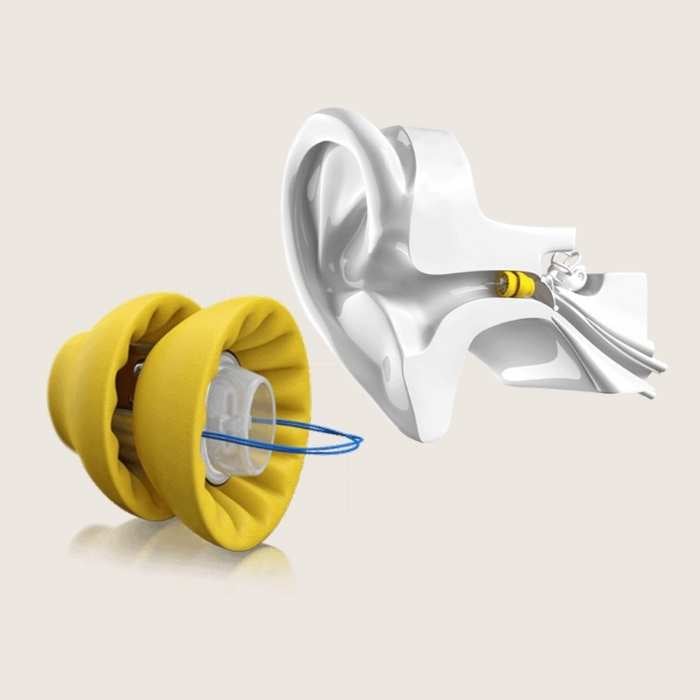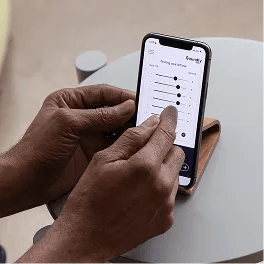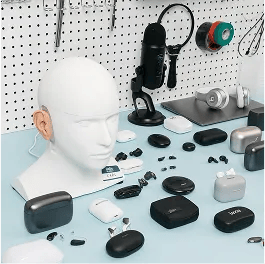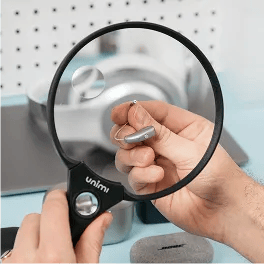Looking for invisible hearing aids?
As an audiologist with experience at Mayo Clinic and Michigan Ear, I’ve consulted with hundreds of patients who start with a similar question.
What are the smallest hearing aids I can reasonably get, and what are the tradeoffs that come with invisible-style devices?
Just like many of the patients I've worked with, I’ll assume you're here in search of a discrete, invisible solution to treat your hearing loss. The great news is that today’s technology has some truly amazing options when it comes to barely visible hearing aids.
In this guide, we'll explore everything you need to know about invisible hearing aids. From comparing them to other styles to highlighting key features to look out for, you'll be equipped with all the information you need to find your perfect (hearing aid) match. So, let’s dive in and make your journey toward better hearing as smooth and enjoyable as possible!
Prefer to watch?
Click play below. Otherwise keep scrolling for the list!
- You have options: Today’s market offers impressive invisible hearing aids, from over-the-counter options like the rechargeable Sony CRE-C20 to custom-built models like the Starkey Signature Series and the continuous-wear Phonak Lyric.
- Don't rule out RIC: Receiver-in-canal devices can also provide a low-profile look, using a slim, clear wire for a discreet fit.
- Bluetooth tradeoffs: Fully in-ear models are compact and hidden, though they generally lack streaming capabilities compared to other styles.
Quick Links
Best OTC Value: Sony CRE-C20
Smallest Rechargeable: Eargo 7
Smallest Overall: Phonak Lyric
Best Custom Mold: Starkey Signature Series
- 50+ hearing aid brands reviewed and rated by our team of hearing aid wearers and audiologists
- 200+ hours each month spent researching brands and care options
- 2,000,000 people shopped on Soundly in 2024
- 100% independently owned and operated
Read more about our company, services and process here.
Featured in this article
Let’s start with our favorite invisible over-the-counter (OTC) hearing aids.
If you prefer to skip the doctor's office and save some money, you may be considering invisible-style OTC hearing aids. Our favorite option for most folks is Sony CRE-C10. Eargo is more expensive but offers incredible design and excellent sound-quality. MDHearing is our top choice for less than $500.
Sony CRE-C20
- Soundly's top-selling in-ear OTC hearing aid
- Nearly invisible in most ears
- 28-hour battery life per charge
- Self-fits through Sony's smartphone app
Sony’s CRE-C20 is a big step up for in-ear OTC hearing aids, packing new features that make it our top pick. Here’s why we chose it:
- Sound Quality Boost: Sony borrowed tech from in-clinic product Signia Silk for sound processing, and the difference is clear. The CRE-C20 delivers noticeably better sound than past models.
- Long-Lasting Battery: With 28 hours on a single charge, you can count on the CRE-C20 to get you through a full day.
- Invisible, Comfortable Fit: Designed to be invisible in most ears, the CRE-C20 fits comfortably and stays discreet—even more so than many other IIC models we’ve reviewed. We especially like the slightly curved design that improves in-ear comfort.
If you’re looking for an in-ear OTC hearing aid, the CRE-C20 wins on sound, battery, and comfort.
Sony CRE-C20 is Soundly's top-performing in-ear OTC hearing aid. Our customers love the discretion and sound quality and often comment on how comfortable CRE-C20 is compared to other in-ear options. Some customers do report that the app setup is more involved than simpler products like Lexie or Sennheiser. Some sample review:
- "Over the past few years, I have tried a half-dozen or more OTC hearing aids and none of them were better than the Sony CRE-C20 aids that I have had the opportunity to evaluate. I have tried less costly and more expensive OTC's - doesn't matter - these were the answer to my inability to hear in many situations." - Ern
- "In terms of function, I was very impressed with the overall sound quality once it was dialed in. Initially they sounded a bit tinny, but that was easily adjusted with the Sound Balance control. It took a couple of days of use and adjusting before I really felt they were dialed in. At that point I wore them all day in different environments to put them through their paces. One of my main concerns is the ability to hear clearly and understand what the person I’m speaking with is saying in a louder environment. The CRE-20Es did a fantastic job with toning out the background noise and producing a clear and easy to understand conversation experience. I tend to have to listen and read lips at the same time but quickly realized I could hear the conversation very well, even in a loud restaurant environment." - Stanley
- "These are IP68 Sweat and water resistant - I was able to wear these biking multiple times without any fear of them falling out or being damaged." - James
- "I shut down and restarted the app, turned off my phone, uninstalled and reinstalled the app, and nothing seemed to work. I tried the next day, and then it worked." - Trobadaur
- C20 is Nearly invisible in most ear canals
- High quality sound for a lower price
- Self-fit at home
- Rechargeable with 28 hours of battery life
- Does not allow Bluetooth streaming
- Requires some tech-savvy for setup
- Only for mild-moderate hearing loss
- Sony CRE-C20 hearing aids are sold over the counter and are appropriate for those with mild-moderate hearing loss
- If you have more significant hearing loss it is recommended that you access professional care through Telehealth or local care
- Available for purchase here Soundly.com with a complimentary guide setup service
- Does not require a prescription from a doctor
- Customize your hearing aids with an onboard hearing test and app-controls
- Sony CRE-C20 is made in collaboration with hearing leader WSA audiology
- Sony CRE-C20 offers good background noise management algorithms and newly re-designed processing chip
- Sony CRE-C20 sits discreetly in the ear and comes with various ear tip sizes
- Sony CRE-C20 is not custom-molded to your ear shape
- Our team finds all in-the-ear models slightly less comfortable for all-day wear than RIC hearing aids
- Sits inside the ear
- Only available in one completely-in-canal size (invisible in many ears)
- Only available in black
- Sony CRE-C20 has rechargeable batteries
- Sony CRE-C20 batteries last 28 hours on a single charge
- The included CRE-C20 carry-case comes with three additional on-the go charges
- Sony CRE-C20 does not come with Bluetooth streaming
- Sony CRE-C20 is a small device which can pose dexterity challenges
- Sony CRE-C20 uses rechargeable batteries and has a convenient charge case with strong magnets that pull the devices into place
- CRE-C20 is water resistant but we recommend you avoid water activities while wearing (i.e. swimming)
- Sony CRE-C20 uses a smartphone app which includes an onboard hearing test and manual controls for bass, treble and volume
- The app is required to make changes (no buttons onboard)
Eargo
- Disruptive leader in hearing health, known for sleek, invisible design.
- Rechargeable with a patented ear tip that allows ears to breathe.
- Eargo 8 adapts to your environment automatically throughout the day.
- Budget models (Eargo SE and Eargo LINK) offer lower prices and alternate features.
Eargo has long set the standard for invisible-style design in the hearing aid industry. Their compact devices, along with an intuitive app and thoughtful packaging, make Eargo a standout choice for early adopters. Here’s why we picked it:
- Invisible Design: The Eargo 8 is one of the smallest rechargeable hearing aids on the market, rivaled only by the Sony CRE-C20.
- Reduced Occlusion: Eargo’s patented “floating” ear tip design sits comfortably in the ear without causing occlusion, a common issue for in-ear hearing aid users.
- User-Friendly App: The Eargo app is easy to navigate, and it allows audiologists to remotely adjust your devices as needed, though most adjustments can be managed directly in the app.
Eargo has received numerous customer reviews, reflecting a generally positive reception.
Overall
Customers frequently commend Eargo for its discreet design, sound quality, and responsive customer service. Many users highlight the significant improvement in their hearing experience and the comfort of the devices.
Positives
- Discreet Design: "The Eargo hearing aids are virtually invisible, and no one can tell I'm wearing them." — James D.
- Sound Quality: "The clarity of sound is remarkable; I can hear conversations clearly even in noisy environments." — Charlie B.
- Customer Service: "Eargo's support team was incredibly helpful and guided me through the setup process with ease." — Rowdy G.
Complaints
While the majority of feedback is positive, some customers have reported issues with device durability and the need for adjustments. However, these concerns are relatively infrequent compared to the overall satisfaction expressed by users.
For a comprehensive view of customer experiences, you can visit Eargo's review page.
- Eargo is a tiny, rechargeable device that sits entirely inside the ear
- Eargo uses a unique design that prevents occlusion
- Eargo is self-fit using an app but offers remote support
- Only appropriate for those with mild to moderate hearing loss
- Requires some tinkering to fine tune the product
- Eargo is not Bluetooth enabled due to the tiny size
- Eargo 8 hearing aids are sold over the counter and are appropriate for those with mild-moderate hearing loss
- If you have more significant hearing loss it is recommended that you access professional care through Telehealth or local care
- Available for purchase online or at retail stores like Verizon Victra and Best Buy
- Does not require a prescription from a doctor
- Customize your hearing aids with an onboard hearing test and app-controls
- Eargo has well-developed background noise management algorithms
- Smart Sound Adjust automatically adapts to your environment and focuses on voices
- Eargo sits inside of the ear and is one of the most comfortable in-ear options on the market
- Eargo creates less occlusion than many in-the-ear options
- Our team finds all in-the-ear models slightly less comfortable than RIC hearing aids
- Sit inside the ear
- Only available in one completely-in-canal size (nearly invisible in many ears)
- Only available in black
- Eargo hearing aids are rechargeable
- 16 hours of battery life on a single charge
- Each pair of hearing aids comes with a small and portable recharge case that carries 14 additional charges
- Eargo 8 does not offer Bluetooth streaming
- Eargo 8 is small but comes with rechargeable batteries which prevents difficult battery changes
- Eargo's devices include a pull-tab that makes it easier to place and remove the devices in your ears
- Eargo 8 hearing aids have an IP68 rating, meaning they can be submerged in up to one meter of water for 30 minutes without damage.
- Eargo 8 pairs with a smartphone app that includes an onboard hearing test and manual controls for programs, volume, and sound quality.
- You can also adjust volume and switch programs without the app by simply double-tapping your ear.
MDHearing Volt Max
- Quality hearing aids under $300, accessible to budget-conscious buyers.
- Simple on-device controls, no Bluetooth or app needed.
- Over 1 million devices sold, backed by reliable customer service.
MDHearing stands out as one of the original direct-to-consumer hearing aid brands, having sold over a million affordable devices even before the FDA established official OTC hearing aid guidelines. Here’s what we like:
- Trusted Brand: MDHearing is backed by a real team, including audiologists, and has sold over a million hearing aids, which provides solid peace of mind for users.
- Simplicity: With straightforward devices that don’t require tech expertise, MDHearing offers an easy-to-use solution for those who prefer minimal setup.
- Range of Styles: MDHearing provides various styles, from in-ear to behind-the-ear options, catering to different comfort and fit preferences.
MDHearing maintains a solid 4.3 rating from over 5,000 customers. Most customers praise MD's affordable prices and easy setup. Some customers complain about feedback, fit and less than desired sound quality.
Supporters
- "These hearing aids are a game changer! I knew I was having trouble hearing low talkers and I'm crowded spaces but once I started wearing these out was like a whole new world opened up. I can hear birds singing, I can hear students in the back of the classroom. Now if I try to take them out, it sounds like I have cotton balls in my ears." - Kim C.
- "I would recommend md hearing aids to anyone having hearing issues, I've been fighting my hearing issues for several years and have even used the more costly aids. Md hearing aids have helped me greatly, give them a chance, it's worth it. Md also gives good support following up on their products. It's nice to be able to hear the TV and people talkiRead more about review stating I would recommend md hearingng." James W
Detractors
- "Have trouble with not losing them they fall out of my ear" - Doug H
- "No matter what setting I have them at, they whistle. Can only use one at a time, which doesn't allow me to hear all around me." - Bruce P
- "I cannot get the adjustment to reduce background enough to be able to hear people speaking to me." Jose M
- Less than $500 for a pair
- Rechargeable
- Multiple styles available
- No Bluetooth streaming
- Slightly larger size
- Only one color available
- Less advanced sound processing
- MDHearing offers OTC products appropriate for mild-moderate hearing loss levels
- If you have more significant hearing loss you might consider local or Telehealth care. Read more about prescription Vs. OTC hearing aids here
- Available for purchase online
- Does not require a prescription from a doctor
- MDHearing offers limited options for customization
- MDHearing is less effective than leading prescription devices in background noise (although significantly more affordable)
- Comfortable thin-tube is great for all day wear
- We suggest that you change the eartips on this product for additional comfort
- MDHearing's in-ear devices are slightly less comfortable due to "occlusion" (boominess of your voice)
- MDHearing offers both behind-the-ear and in-the-ear devices
- Devices are slightly larger than other OTC options
- Available in only beige
- MDHearing has built-in rechargeable batteries that last up to 20 hours on a single charge
- MDHearing hearing aids come with a recharge case that carries additional portable charge
- MDHearing devices do not allow Bluetooth streaming or app controls
- MDHearing's behind-the-ear options are reasonably easy to handle but do require the wearer to place the hearing aid behind their ear and insert the receiver into the ear (consistent across all behind-the-ear styles)
- MDHearing devices are rechargeable and do not require battery changes
- MDHearing devices are not advertised as waterproof. Avoid moisture if possible
- MDHearing devices use onboard buttons to change programs and volume
Let’s move on to our favorite prescription invisible hearing aids.
These are our current favorites among prescription devices (found only in clinic):
Starkey Signature Series - Starkey Signature Series is broadly considered the leader among custom-molded products. Starkey's slightly larger CIC hearing aid comes with Bluetooth streaming (the smallest Bluetooth device in the category).
Oticon Own - Oticon Own comes with intelligent sound processing and an impressively compact IIC. If you've worn Oticon in the past, you'll recognize the open good quality that is the signature of this brand.
Signia Silk - Signia Silk is a prescription device with rechargeable batteries and ready-wear design. Customers will not need a custom-mold for this device but will still have access to a doctor's fine-tuning within the sound-settings. Signia Silk and Sony CRE-C10 are built by the same manufacturer.
Starkey Signature Series
- Latest custom hearing aid line from Starkey, a leader in custom styles
- Made in the U.S. with options from fully invisible to larger rechargeable models
- Powered by Starkey’s AI-enabled Neuro processor for enhanced background noise management
Starkey's Signature Series leverages a long history in custom hearing aids, even trusted by President Ronald Reagan in the 1980s. Here’s why it stands out:
- Custom Fit: Each Signature Series device is crafted to each user’s ear from an in-clinic ear impression, providing unmatched comfort and discreetness.
- Versatile Styles: From a nearly invisible-in-the-canal (IIC) model to a larger rechargeable style with up to 38 hours of power and IP68 water resistance, the Signature Series offers flexibility to suit different needs.
- American-Made Quality: Starkey is the only major hearing aid manufacturer based in the U.S., combining local innovation with decades of expertise.
Starkey’s commitment to personalized, high-quality hearing solutions has made it a trusted name for generations.
- Smallest models are almost entirely invisible
- Starkey is a leader in comfortable custom molded products
- Larger sizes come with Bluetooth rechargeable batteries
- This is a premium device which costs $3,000-$7,000 per pair
- Custom molds require additional lead time and replacement time
- The smallest version of Starkey Genesis AI customs are not rechargeable
- None of the Signature Series devices are Bluetooth enabled
- Regardless of size, Starkey Genesis AI hearing aids are fully customizable, prescription hearing aid appropriate for mild-severe hearing loss
- If you have profound hearing loss, you may be a better fit for Starkey's BTE-style hearing aids
- Starkey Genesis AI hearing aids are prescription devices fit and programmed by a professional
- To create your custom hearing aids, a professional will take earmold impressions in a clinic or in your home. They will then send those impressions to the Starkey manufacturing facility where a one-of-one replica will be created for your hearing aids
- After an initial fitting, you can connect with your care provider remotely through the Starkey app
- Starkey Genesis AI hearing aids come with robust background noise management features including Starkey's deep neural network that makes up to 80M adjustments per hour to match your environment
- Genesis AI custom-molded devices sit comfortably in the ear. Some users with better hearing in lower frequencies prefer an open-fit behind-the-ear style hearing aid that allows more natural sound to pass into the ear canal.
Learn more about the choice between in-the-ear vs. behind the ear styles here.
- Sit inside the ear
- Available sizes include full-shell, half-shell, completely-in-the-canal, invisible-in-canal
- Starkey offers 5 colors including black, pink, light brown, medium brown and dark brown
- Starkey's IIC style is on our list of the best invisible hearing aids available
- Starkey's half-shell and full-shell models are rechargeable with up to 36 hours of battery life
- Starkey's completely-in-canal and invisible-in-canal models use a size 10 disposable battery (lasts 5-7 days)
- Genesis AI offers Bluetooth streaming in full-shell and half-shell models
- Genesis AI does not offer Bluetooth streaming for completely-in-canal (CIC) or invisible-in-canal (IIC) models
- iPhone users can take calls hands-free, while Android users must keep their phones close to pick up outbound audio.
- Genesis AI devices use Apple's MFI connection and Android's ASHA connection to stream content through Bluetooth
The larger, rechargeable models of Genesis AI custom-molded hearing aids are reasonably easy to handle, while the smaller, disposable battery-powered models require more dexterity.
- All models have a single piece that sits in the ear vs. RIC styles with a piece in and behind the ear
- Larger sizes include a push button, while smaller sizes do not
- Rechargeable models use port charging vs. conduction charging (slightly more challenging to handle)
- The smallest sizes require regular battery changes (requires good dexterity)
- Starkey Genesis AI are water resistant with an IP rating of 68
- This hearing aid can withstand dust and water submersion in one meter of water for up to 30 minutes
- Remote care: available through the app with care provider coordination
- Customization: Edge Mode and adjustments in the app
- Tinnitus masking: programs can be created by your hearing healthcare provider
- Find my hearing aid: yes
- Health tracking: activity tracking
Note that Starkey's CIC and IIC sizes do not come with connection to the Starkey app.
Oticon Own
- Custom-molded in-ear hearing aids, tailored for a discreet fit
- Options range from completely-in-canal styles to larger, rechargeable models
- Professionally programmed by a hearing care provider for a personalized setup
- Price range: $3,000 - $5,500 per pair, depending on features and size
For those who appreciate Oticon’s sound quality but prefer an in-ear option over a behind-the-ear format, Oticon Own offers a great alternative. Here’s why we chose it:
- Custom Fit: Each Oticon Own device is custom-molded for comfort and discretion, offering a tailored fit that blends seamlessly into your ear.
- In-Ear Streaming: Larger models support full Bluetooth streaming for both Android and iPhone, allowing you to enjoy phone calls, music, and other audio hands-free.
- Proven Sound Processing: Powered by Oticon’s 2022 sound system, previously used in Oticon Real, Oticon Own brings advanced noise handling and clarity into a small, in-ear design—ideal for users who want powerful hearing support without the bulk of traditional hearing aids.
- Oticon Own hearing aids are designed for mild to severe hearing loss, making them a versatile option for many users.
- They are available in IIC and CIC sizes, which are discreet and comfortable to wear.
- They include an optional push button or volume wheel, as well as binaural connection between hearing aids to improve directionality, giving users more control over their hearing aids.
- ITC and Full-Shell sizes allow for Bluetooth connection and telehealth programming after an initial appointment.
- Oticon Own hearing aids are only available through prescription channels, so you'll need to purchase them locally instead of over-the-counter or through telehealth.
- They are a premium-priced product, which may not be affordable for all users.
- Oticon Own does not offer a rechargeable option.
- Regardless of size, Oticon Own hearing aids are fully customizable, prescription hearing aid appropriate for mild-severe hearing loss
- If you have profound hearing loss, you may be a better fit for Oticon's Xceed hearing aids
- Oticon Own hearing aids are prescription devices fit and programmed by a professional
- To create your custom hearing aids, a professional will take earmold impressions in a clinic or in your home. They will then send those impressions to the Oticon manufacturing facility where a one-of-one replica will be created for your hearing aids
- After an initial fitting, you can connect with your care provider remotely through the Oticon Companion app
- Own uses Oticon's deep neural network to sort background noise from speech. Many users describe Oticon's sound quality as "relaxed", "natural" and "comfortable."
- Oticon Own custom-molded devices sit comfortably in the ear. Some users with better hearing in lower frequencies prefer an open-fit behind-the-ear style hearing aid that allows more natural sound to pass into the ear canal.
Learn more about the choice between in-the-ear vs. behind the ear styles here.
- Sit inside the ear
- Available sizes include full-shell, half-shell, in-the-canal (ITC), completely-in-the-canal (CIC), invisible-in-canal (IIC)
- Oticon offers 5 colors including black, beige, light brown, medium brown and dark brown
Oticon Own hearing aids all use disposable batteries
- Full-shell (FS), half-shell (HS), and In-The-Canal (ITC) models use a 312 battery (lasts 7-10 days)
- Completely-in-canal (CIC), and Invisible-In-Canal (IIC) models use a size 10 battery (lasts 5-7 days)
- Oticon Own offers Bluetooth streaming or Telecoil in the three largest styles (FS, HS and ITC)
- Smaller models (CIC and IIC) do not allow Bluetooth streaming or Telecoil
- iPhone users can take calls hands-free, while Android users must keep their phones close to pick up outbound audio
- Oticon Real devices use Apple's MFI connection and Android's ASHA connection to stream content through Bluetooth
- All sizes and styles within the Oticon Own family require regular disposable battery changes and good dexterity. The smallest two sizes (CIC and IIC) are especially difficult to manage due to their smaller size 10 battery.
- Oticon Own hearing aids are water resistant with an IP rating of 68
- This hearing aid can withstand dust and water submersion in one meter of water for up to 30 minutes
- Remote care: included in the new Oticon Companion app
- Customization: volume, program change, streaming sound quality (treble/bass), SpeechBooster
- Tinnitus masking: your hearing care provider can create a tinnitus masking program
- Find my hearing aid: available in the app
- Health tracking: not available
Note that Oticon Own CIC and IIC sizes do not come with connection to the Oticon Companion app.
Signia Silk
- Virtually invisible fit, fully inside the ear canal
- Smallest rechargeable prescription hearing aid with all-day battery and portable charger
- Dual processors for clear speech in noisy settings, with natural Own Voice Processing (OVP)
- Ready-to-wear with pre-sized click sleeves, no custom molds needed
Signia Silk stands out for its near-invisibility and comfort, offering a discreet in-the-ear design that fits entirely within the ear canal. Here’s why we picked it:
- Invisible Comfort: Signia Silk is one of the smallest in-the-ear hearing aids, making it practically invisible to others.
- Rechargeable Power: It’s the tiniest rechargeable option, giving a full day’s use and coming with a portable charging case for quick and easy recharges on the go.
- Advanced Sound Processing: With dual processors, Signia Silk provides clear speech in noisy environments, while Own Voice Processing (OVP) minimizes the volume of your voice, creating a more natural hearing experience.
- No Custom Molds Needed: Designed for convenience, it’s ready-to-wear with pre-sized click sleeves, skipping the need for custom molds and simplifying fittings.
Users appreciate the discreet design, clear sound quality, and rechargeable batteries. However, some are concerned about the lack of onboard buttons and lack of Bluetooth streaming. Here are a few sample reviews from our partners at Zip Hearing.
- "I have been able to hear sounds I have not heard before. Concerned about the on/off situation. The charging is great, no battery to change." - Tom
- "These Signia Silk Charge&Go hearing aids are miraculous: they are hidden in your ear and basically invisible, but rechargeable, adjustable via the app on your mobile phone and they deliver great quality sound-even in noisy places like restaurants. And no fitting it’s required because they come with multiple size rubber ear pieces, so they’re good to go on your first audiologist visit. Dazzling!" - Allen
- "I'm really impressed with my Signia Silk Charge and Go 7IX. WIth the right provider, I now find them comfortable to wear all day and the difference in my hearing acuity before and after, is amazing. The unfortunate trade off, between supper small CIC's and no blue tooth (that's why I gave them a 4.5), for me, is acceptable." - Jean
- Nearly invisible Professionally programmed
- No custom-mold required
- Rechargeable batteries
- Premium price point $2,998 - $5,000 for a pair
- Requires an in person office visit
- No Bluetooth features due to the size
- No onboard buttons (requires app or remote control)
- Signia Silk hearing aids are appropriate for mild-severe hearing loss
- Silk devices are not custom-molded and may create feedback in some severe cases
- If you have profound hearing loss, you may be a better fit for high-powered BTE hearing aids (not currently offered by Signia)
- Signia hearing aids are prescription devices fit and programmed by a professional
- Unlike other leading in-the-ear style devices, Signia Silk does not require a custom-earmold. Instead the device comes with a range of Click Sleeves that fit a wide range of ears
- After an initial fitting, you can connect with your care provider remotely through the Signia app for fine-tuning and program changes
- Signia uses a unique Split Processing technique helps isolate background noise and boost speech clarity
- Signia's Own Voice Processing (OVP) helps take the edge off of that uncomfortable sound quality of the user's own voice that many patients experience when adjusting to hearing aids
- Signia Silk hearing aids are slightly less comfortable than custom-molded alternatives
- Sit inside the ear
- Only available in one completely-in-canal size (nearly invisible in many ears)
- Choose from two faceplate colors: Black and Mocha
- Signia Silk hearing aids use disposable size 10 batteries (lasts 5-7 days)
- Signia Silk does not come with Bluetooth streaming
- Signia Silk requires regular disposable battery changes and good dexterity.
- Signia Silk hearing aids are not advertised as water resistant. Keep these devices away from water when possible.
- Remote care: Included in the Signia app (not a separate app)
- Customization: Treble/bass, volume, microphone directionality, Signia Assistant
- Tinnitus masking: Customizable options through your hearing care professional
- Find my hearing aid: Not available
- Health tracking: Step tracking, activity (e.g., high intensity versus low), and wear time
The Smallest Option On The Market
Phonak Lyric is a unique product that sits entirely inside your ear canal 24 hours a day. It is the only truly invisible option on this list and gets rave reviews from users.
Phonak Lyric
- Smallest hearing aid available, designed to sit fully in the ear canal for 24/7 wear
- Replaced every 6-8 weeks for consistently fresh performance
- Waterproof, allowing for swimming and showers without removal
- Delivers natural analog sound with minimal processing, but limited background noise management
Phonak Lyric is a truly unique hearing aid on the market, offering an entirely invisible, "set it and forget it" solution for users seeking simplicity and discretion.
- Effortless Wear: Lyric is designed for continuous, worry-free wear. It stays in place 24/7 and is replaced every 8 weeks by a professional, making it an excellent option for those who prefer not to manage their hearing aid daily. Some users can even learn to change it at home.
- Complete Discretion: Lyric’s position deep in the ear canal makes it truly invisible. Even with close inspection, it’s undetectable, giving users complete confidence in its discreteness.
- Ideal for Dexterity Challenges: With no daily handling required, Lyric is ideal for individuals with dexterity issues or those who prefer a low-maintenance solution. Its effortless setup offers ease without compromising on hearing clarity.
Phonak Lyric combines practicality and innovation, making it a compelling choice for anyone that has the time and resources to go this route.
- Totally invisible Wear 24 hours a day including workouts and water
- Clear sound that uses the natural shape of the ear
- Expensive at $4,000 per year
- Includes in-person changes every 8 weeks
- Lack of background noise suppression technology
- No Bluetooth streaming
- Phonak Lyric hearing aids are appropriate for mild-severe hearing loss
- If you have profound hearing loss, you are a better fit for higher-powered RIC or BTE hearing aids
- Phonak Lyric hearing aids are prescription devices fit and programmed by a professional
- You will return to your audiologist every 8 weeks for hearing aid replacements
- Some users learn to make hearing aid changes themselves at home using a special insertion tool
- Phonak Lyric uses analog sound, preferred by some users, though it lacks advanced background noise management features.
- Lyric benefits from the natural acoustics of the ear canal, which can help improve background noise handling.
- After an initial adjustment period, Phonak Lyric becomes comfortable for most users, with many reporting they forget they're even wearing hearing aids.
- Sit deep inside the ear
- Replaceable using a special insertion tool at your local clinic
- Phonak Lyric devices have an onboard battery that lasts 6-8 weeks, after which the entire unit is replaced.
- Phonak Lyric does not come with Bluetooth streaming
- Phonak Lyric is professionally placed and stays in the ear for 6-8 weeks, making it ideal for users with dexterity challenges.
- Phonak Lyric is water-resistant, allowing for light swimming, daily showers, and exposure to humidity.
- Phonak Lyric does not have an app
- Volume and program changes are made using a magnetic wand accessory

Hearing Aid Styles Explained
Hearing aids can come in different styles. The two primary styles are:
- Receiver-in-Canal (RIC): These are very discrete for most wearers, with a small portion behind the ear connected to a tiny speaker inside the ear canal.
- In-Ear Hearing Aids: These devices are worn in your ear canal, with sizes ranging from totally invisible to a bit more visible.
.jpeg)
There are four common types of in-the-ear hearing aids that you will find online or at an audiologist.
Invisible In The Canal (IIC) - This tiny style sits inside your ear canal with only a pull tab visible to remove the device.
Completely In Canal (CIC) - The top of the hearing aid is visible to those looking from the side, but the device is very discreet.
In The Canal (ITC) - Comfortable but visible. More easily accessed to change the volume or mode.
ITE - This style is even more accessible and allows for more power and, in some cases, rechargeability and Bluetooth.
Most people who prefer invisible hearing aids will gravitate towards IIC or CIC styles.
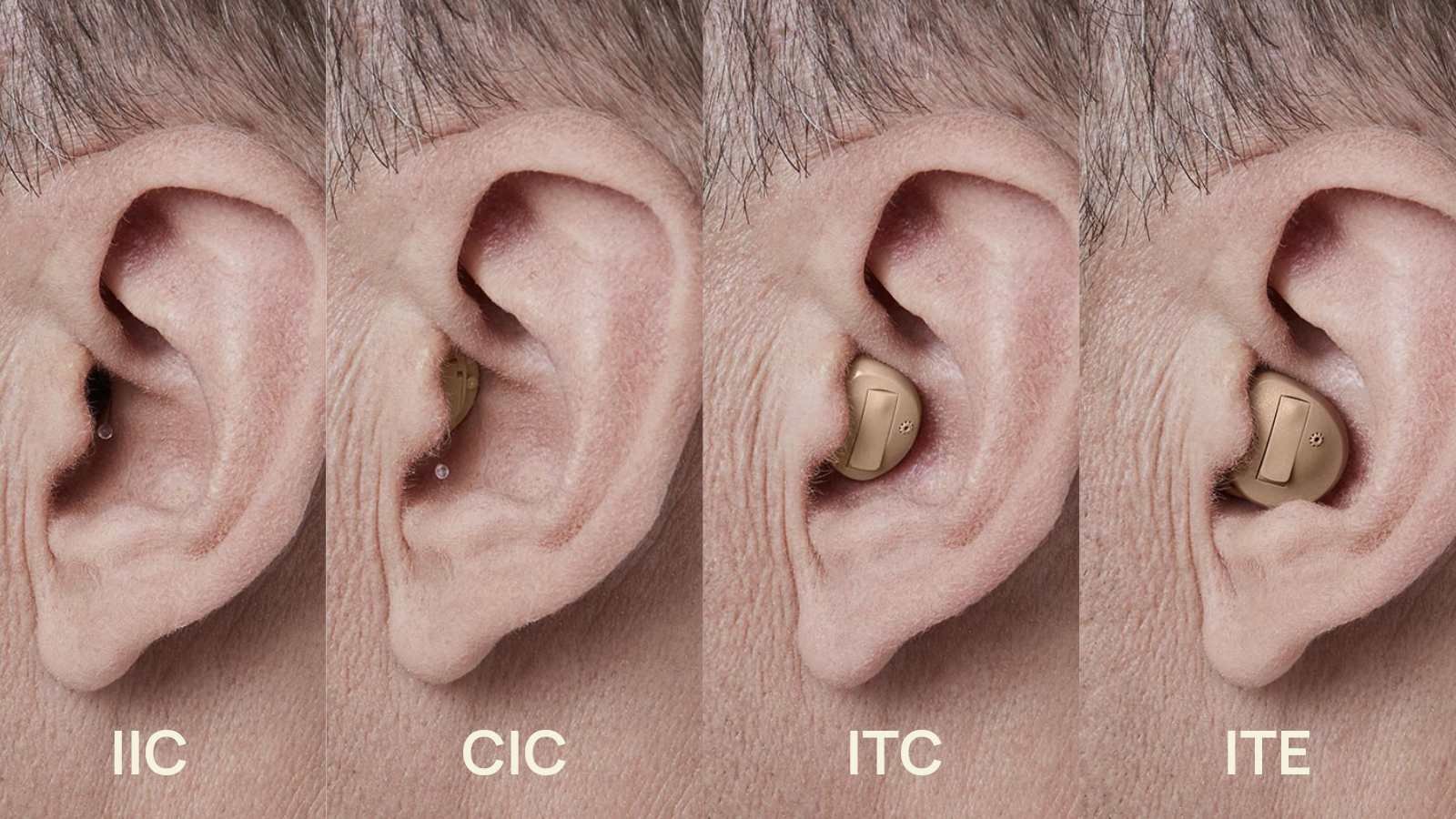
Is An Invisible-In-Canal (IIC) Hearing Aid Right for You?
While there are some great invisible-style devices on the market, choosing a hearing aid that sits fully in the ear comes with some considerations. Here are a few questions to ask.
1) What's your low frequency hearing like?
If your hearing is normal or you have a mild low-frequency hearing loss, you might find the occluded sound from an Invisible-in-the-Canal (IIC) hearing aid a bit annoying. It can make everything sound more "plugged" and less natural, which isn't ideal for everyone. Sometimes patients decide to go ahead, knowing that this will take some adjustment.
2) How important is Bluetooth connectivity for you (i.e., streaming audio and phone calls)?
Another key consideration is the feature set you're looking for. If having Bluetooth functionality and app control is high on your priority list, then the smallest hearing aids might not be the best fit for you. These advanced features typically aren't available in the tiniest models due to their compact size. Of course, you can still take phone calls by holding your phone up to your ear or using a speakerphone. Again, some patients decide that ultimate discreteness is higher on their priority list than these features.
3) Do you need rechargeability?
Rechargeable devices are the most popular option for RICs, and it's easy to understand why. Devices charge up each night and are ready to go in the morning, no battery-changing worries. That's ideal for those with dexterity challenges, as it's easier to charge than to open a battery door and change batteries. However, the tiniest devices today generally still rely on size 10 batteries, which are the smallest hearing aid batteries. (Note: one exception here is the Phonak Lyric which doesn't require changing batteries and instead will be replaced on a regular 6-8 week visit with your clinician.)
4) Do you have a wax problem?
This won't affect most people, as the ear is generally self-cleaning and doesn't pose a problem for most. However, if you are someone who gets wax impaction from regular wax build-up, it's worth a thought here. No matter what style hearing aid you select, you'll likely want to either see an ENT or audiologist on a regular basis for cleaning or use another strategy to manage it. Additionally, you'll want to be extra vigilant with replacing wax guards and cleaning, as wax is the most common patient complaint when a hearing aid isn't working properly.
A Compelling Alternative to IIC Hearing Aids.
If you prioritize any of the points listed above, don’t worry, there is another discreet option that can work. In fact, most hearing aid wearers choose behind-the-ear hearing aids for their comfort, functionality and, yes, relative invisibility.
I know - you're probably thinking "won't that be more noticeable?" Often these devices blend in with hair or blend with the rim of glasses for those who wear them. Let's take a look:
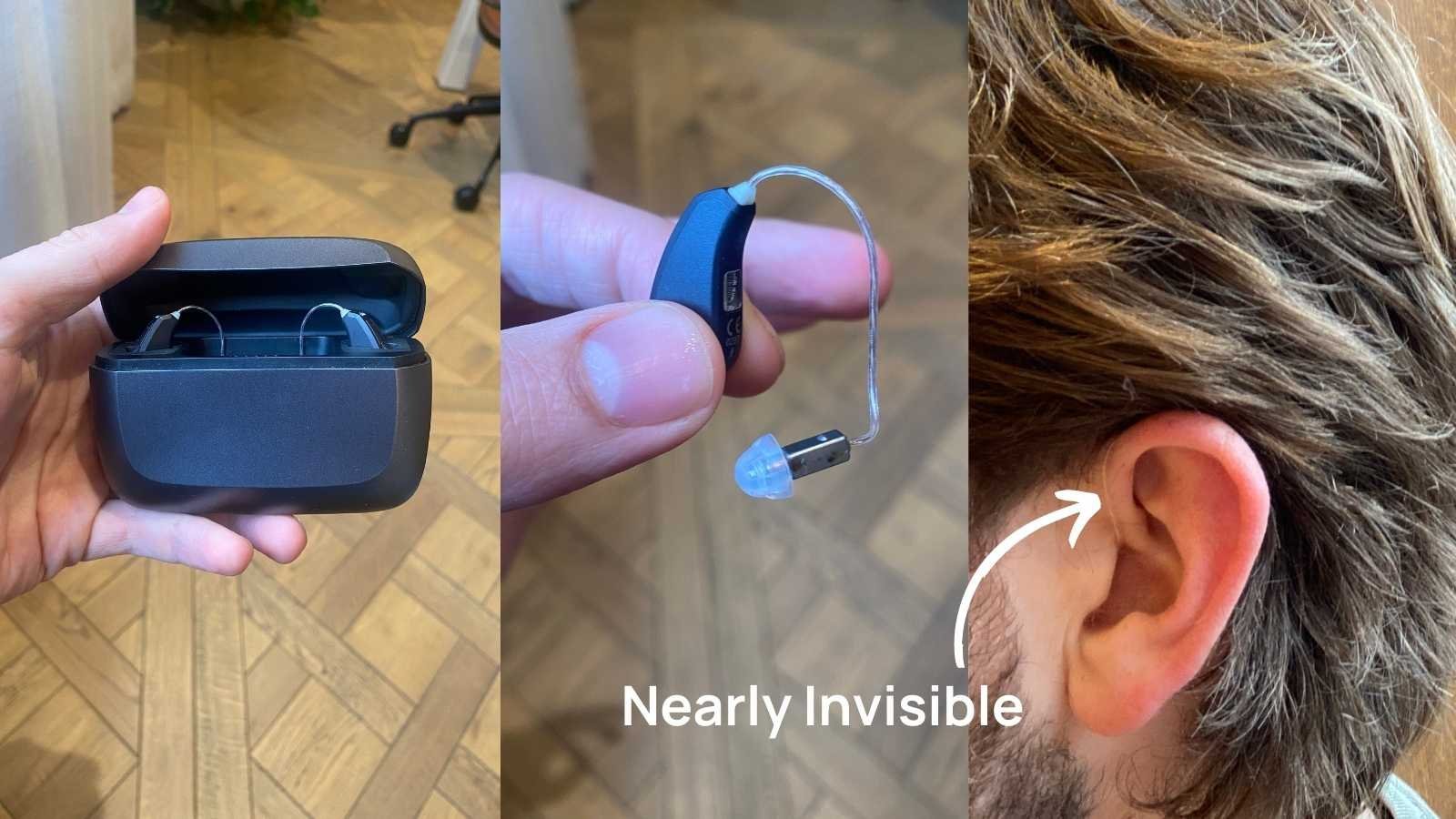
While in-canal hearing aids are known for their discreet fit and minimal visibility, RIC hearing aids offer a unique blend of subtlety and functionality. With RIC devices, the receiver, or speaker, sits directly in the ear canal while the microphone and processor rest behind the ear, connected by a thin wire.
This design not only enhances sound quality and unlocks modern features like Bluetooth streaming, but also makes the hearing aid nearly invisible, especially with the ultra-thin wire blending that blends right in.
They provide a comfortable, high-performance option that combines advanced technology with a barely-there aesthetic—perfect for those who want both invisibility and exceptional hearing support.
Custom Molded Versus ‘Ready to Wear’ Hearing Aids.
Alright, now that we've talked about styles and care models, the next big decision is whether to get a custom-made device or go with a ready-to-wear option. Note that custom-molded devices are only available at local clinics (not through OTC).
Custom Molded Hearing Aids
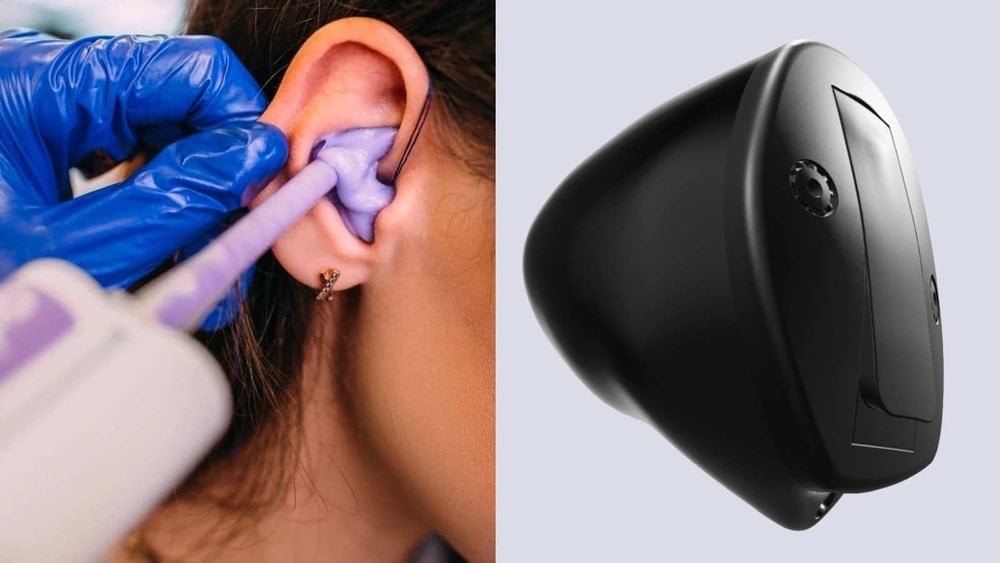
The custom-made option is designed to fit the exact contours of your unique ear canal. The advantage of custom is that it fits your ear perfectly, providing a secure fit. However, this option requires more time because your clinician will need to do an ear impression of your ear.
You can read more about the ear impression process in this piece on custom earplugs (the ear impression process is the same). After taking the impression, it’ll take a few weeks for the lab to receive it, create the custom device, and then send it back to your clinic for your fitting.
Here are the pros and cons of custom hearing aids:
Custom-Mold Pros
- fits perfectly to your ear canal geometry
- options for vents (reduces occlusion effect)
- professional programming to your hearing loss
- amplification for mild to severe hearing loss
- IIC is extremely discrete in most ears
Custom-Mold Cons
- usually pricier than ready-to-wear
- depending on your ear canal, the smallest IIC may not be possible (see anatomy notes below)
- takes several weeks to arrive
- repairs will require sending your device in (meaning no hearing aid while you wait)
- normal hearing to mild hearing loss in the low frequencies can cause 'plugged up' sound
- not right for flat severe or profound hearing loss
Note on Ear Anatomy
One note here about the tiniest IIC hearing aids: even the smallest device requires a certain amount of space to house the internal electronics. For small ear canals, this might mean that it's not feasible to create an IIC, and you may instead need a slightly larger CIC. Your clinician can speak more specifically to your unique ear size and shape and let you know what is possible.
Ready-To-Wear Hearing Aids
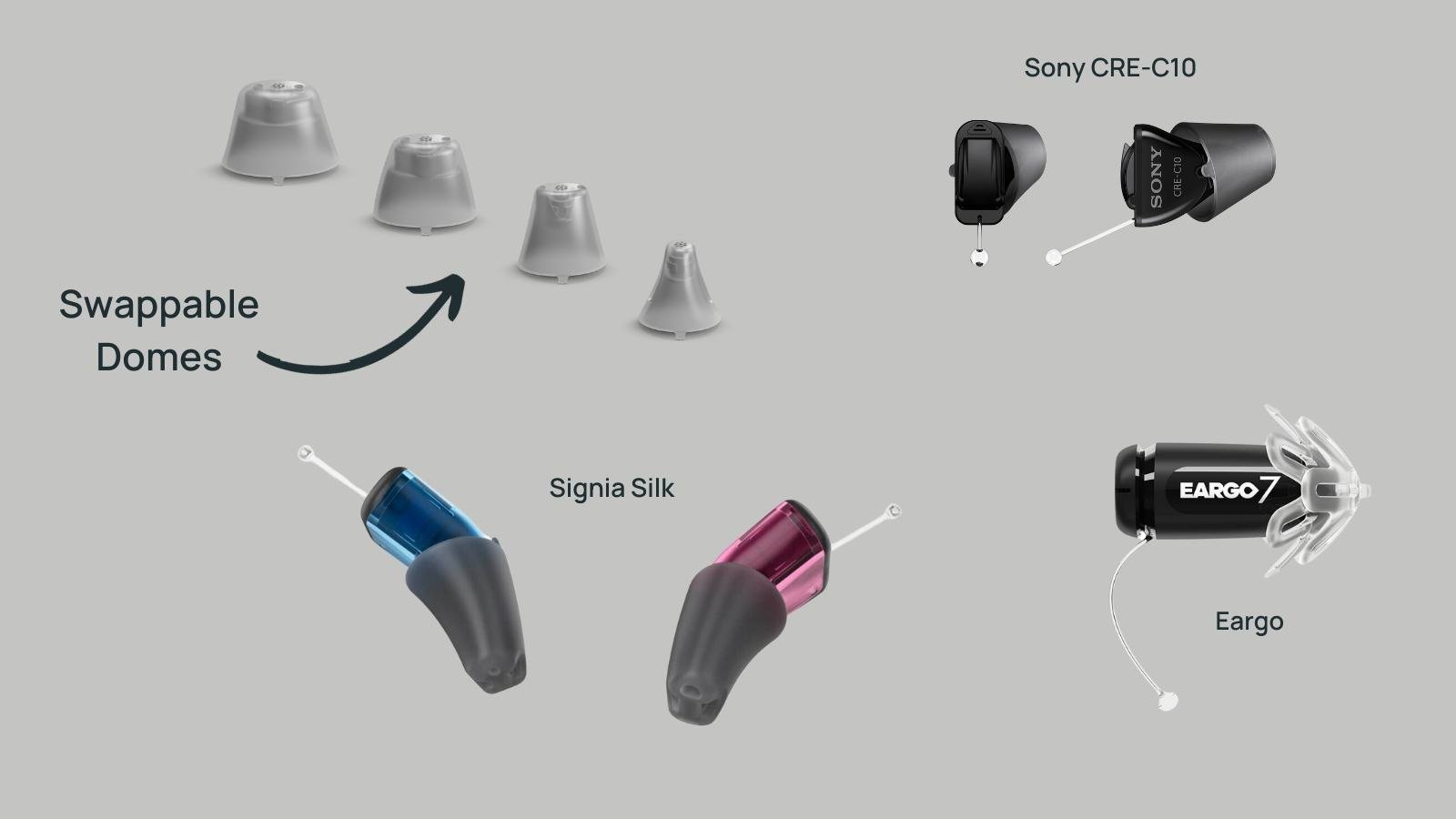
On the other hand, ready-to-wear options are like purchasing a suit off the rack—they’re designed to fit most people reasonably well straight out of the box. These devices will have a dome tip that is placed over the receiver in the ear, and there are different sizes for smaller or larger ear canals. While these may not offer the exact fit of a custom device, they’re a great choice if you need a solution quickly or prefer the convenience of not waiting for a custom device. Let's look at some of the pros and cons for ready-to-wear:
Ready-To-Wear Pros
- fits most ears (dome tips fit smaller or larger ear canals)
- soft dome tips feel comfortable in the ear
- more budget-friendly options than custom
- fits mild to moderate hearing loss
- self-fitting options
- replacement devices available during repair
Ready-To-Wear Cons
- sound feels 'plugged up' for normal hearing to mild hearing loss in low frequencies
- usually less programming customization to fit your hearing loss (with some exceptions)
- not right for more severe hearing loss
- some ready-to-wear devices are more visible in the ear than custom IICs
- fits most ears but not best for unique ear canal anatomy
- less effective in background noise than larger customs or RICs
Some Exceptions
There are several good ready-to-wear options in the OTC self-fitting category. However, some ready-to-wear devices are professionally fit. For example, Phonak's Lyric product is a ready-to-wear device that is professionally placed deeply in your ear canal (and completely invisible). A note here: Lyric comes with a higher price tag than most ready-to-wear options.
The Signia Silk is also a professionally programmed ready-to-wear CIC device. These options provide the convenience of not waiting for custom manufacturing while still offering a high level of professional fitting and programming. These professionally fit devices can be an excellent choice for those who seek both discretion and the assurance of a professional fitting.
Ready To Pursue an Invisible Hearing Aid? Next Up, Choose a Care Model.
Now that you've decided on an in-ear device, let's talk care model differences between prescription devices and over-the-counter (OTC) options. Your decision on which care model suits your needs will help you narrow down your shortlist of brands and products.
Option 1: Over-The-Counter (OTC)
OTC (over-the-counter) hearing aids tend to be more affordable than custom devices, and you can purchase them without needing a prescription from a clinician. They are typically programmed using a smartphone app. This makes them a convenient and cost-effective choice. One upside to OTC devices, you won't need to wait for custom manufacturing or multiple clinic visits.
If you're using hearing aids for the first time, it's essential to remember that there's an adjustment period. Your ears and brain need time to get used to the new sounds, so don’t get discouraged if things feel a bit off at first. Most OTC hearing aids come with a 45-day trial period with a return policy, which is fantastic. It means you can take the time to see if they're beneficial for you. If they don't work out, you can simply return them and try something else (i.e., in-clinic care).
Over-The-Counter Pros
- Generally more affordable than custom devices
- Convenient purchasing process without needing a prescription
- Immediate availability, no waiting for custom manufacturing
- Flexible self-fitting options available
- Good for those with mild to moderate hearing loss
- Trial period and return policy
- Less dependence on professional availability for fittings and adjustments
Over-The-Counter Cons
- Less personalized support compared to prescription devices
- Potentially less comfortable fit due to non-custom design
- Sound quality may not be as refined as that offered by prescription options
- Some devices might still be visible in the ear
- Requires self-guidance for fitting, setup, and troubleshooting
Option 2: Prescription
If you're leaning towards prescription devices, you'll be pleased to know they come with a comprehensive suite of professional services. Your clinician plays an invaluable role here; they're with you every step of the way as you adjust to your new devices.
From the moment you get your prescription hearing aids, your clinician will guide you through the entire process. They'll teach you how to insert and remove your devices correctly, ensuring a secure and comfortable fit each time. Plus, you'll get detailed instructions on how to care for your hearing aids, including cleaning and maintenance routines that will help prolong their life and performance.
One of the standout benefits of prescription devices is the support and follow-up. Should your hearing aids malfunction, your clinician will troubleshoot and resolve your issue. As you're adjusting to your custom device, they can also modify the shape with professional tools to ensure the best, most comfortable fit. Your office can professionally clean and inspect your devices at regular intervals to ensure they are working properly.
Additionally, custom programming services mean your hearing aids will be fine-tuned to match your specific hearing loss profile, offering excellent sound quality and the best listening experience.
Pros
- Comprehensive professional guidance and support through the fitting process
- Custom programming tailored to your specific hearing loss profile
- Secure and comfortable fit, with adjustments made by your clinician (if needed)
- Ongoing support for troubleshooting and resolving issues
- Regular professional cleaning and maintenance to ensure optimal performance
- Enhanced sound quality and listening experience due to personalized settings
Cons
- Typically more expensive than OTC options
- Requires multiple appointments and time for adjustments
- Dependence on professional availability for follow-up services
- May involve wait times for custom manufacturing and fitting
- Limited immediate availability compared to ready-to-wear devices
Alright, now that we've talked about styles, the next big decision is whether to get a custom-made device or go with a ready-to-wear option. Think of this one like a tailor-made suit versus one purchased off the rack.
Final Thoughts
After diving into the details and weighing the pros and cons of both prescription and OTC options, it’s clear that there's a lot to consider.
If you prefer professional guidance and a highly personalized fit, prescription hearing aids from a clinic might be the best route. They ensure a snug and comfortable fit with custom molds, and the hearing aids are specifically programmed to match your hearing loss profile. Plus, you'll get ongoing support and professional cleaning to keep them in top shape. However, they do come with a higher price tag and require multiple appointments.
On the other hand, OTC hearing aids are fantastic for their affordability and convenience. You can get them without a prescription, and many come with flexible self-fitting options. While they may lack the fine-tuning of custom devices and might not handle background noise as well, they offer a great starting point for those new to hearing aids or those with mild to moderate hearing loss. The trial period and return policy are also huge bonuses.
Ultimately, it comes down to your personal preferences and lifestyle. If you’re often in noisy environments, investing in premium prescription aids might be worth it. But if you’re looking for a cost-effective and convenient solution, OTC aids could be a great fit.
Ready to explore the best invisible hearing aids on the market? Visit our website or contact us today for a personalized consultation and take the first step toward improved hearing health with confidence.
Frequently asked questions
Invisible hearing aids work much like traditional hearing aids. Most devices have a pair of microphones that pick up sounds, and the onboard processor then customizes the sound to match your hearing loss, and a speaker plays an amplified sound.
Invisible hearing aids are typically custom-molded to match your ear canal. To create a custom earmold, an audiologist will fill your ear with a silicone paste and let it set. They will then remove the dried mold and ship that mold to the manufacturer.
The manufacturer then builds a one-of-one hearing aid to match your ears and fits the components into that mold.
The result is a comfortable device that sits deep inside your ear.
Prices for invisible hearing aids vary fairly widely, and Prescription-level devices are typically 5K-7K per pair. You can find lower-cost care on this site by following the “find care” button on any page.
Invisible OTC devices start at $999 (Sony CRE-C10) and go up to around $2,600 (Eargo 7).
Most hearing aids last around 3-5 years. Warranties typically last for three years.
Most do not. Starkey’s completely-in-canal hearing aid (one size bigger than their smallest) does come with Bluetooth, and Starkey currently makes the smallest Bluetooth hearing aid on the market.
Most invisible hearing aids require a custom earmold, but there are some newer designs that push back on this trend. Eargo, Signia Silk, and Sony all use read-to-wear styles with various tips or domes to match your ear canal.
Some users report that ready-to-wear invisible hearing aids are less comfortable or don’t sit as far inside the ear canal.
Generally yes. Custom-molded devices should sit comfortably in your ear and will stay out of the way of glasses and masks.
Starkey is the leader in custom-molded products and Eargo is a clear favorite for ready-to-wear products. Full invisible hearing aid guide here.
Yes. Eargo and Sony are the leading invisible OTC hearing aid makers.
Invisible hearing aids can be challenging if you struggle to handle small pieces and batteries. Phonak Lyric can be a good option for seniors who want to set it and forget it until their regular appointments.
If you have small ear canals and want invisible hearing aids, you’ll likely want to get a custom-molded device like Starkey. We’ve found that Eargo can also work well in some small ear canals.
Yes. A quality pair of invisible hearing aids can be fitted to most hearing loss types. Some people with great hearing in low frequencies prefer open-fit hearing aids (these sit behind the ear) because that style allows natural low-frequency sound into the ear instead of blocking it.
Good question. A lot of hearing aids call themselves invisible, but the reality is that every ear canal is different. Phonak Lyric is truly invisible. Most of the others on this list are so discreet that they would rarely be noticed in most ears.
Click the “compare” section of this site. Each invisible-style hearing aid we’ve reviewed has numerous verified customer reviews.




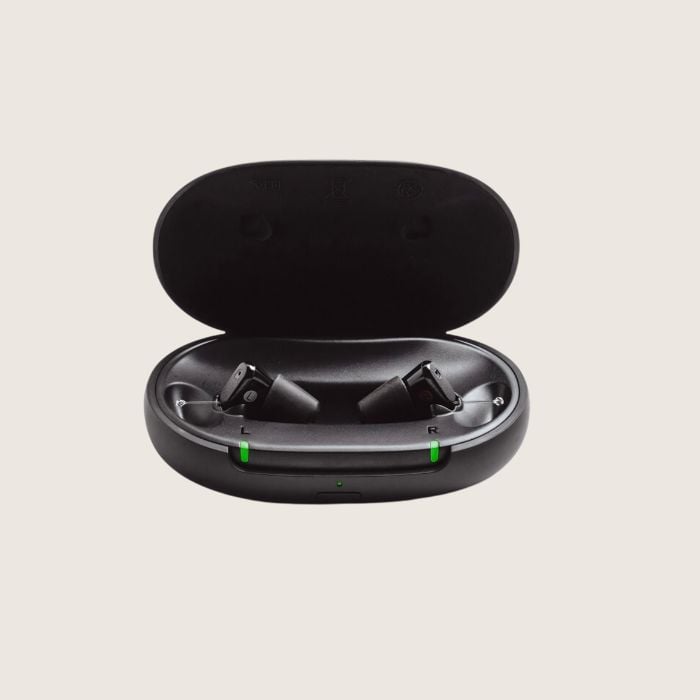
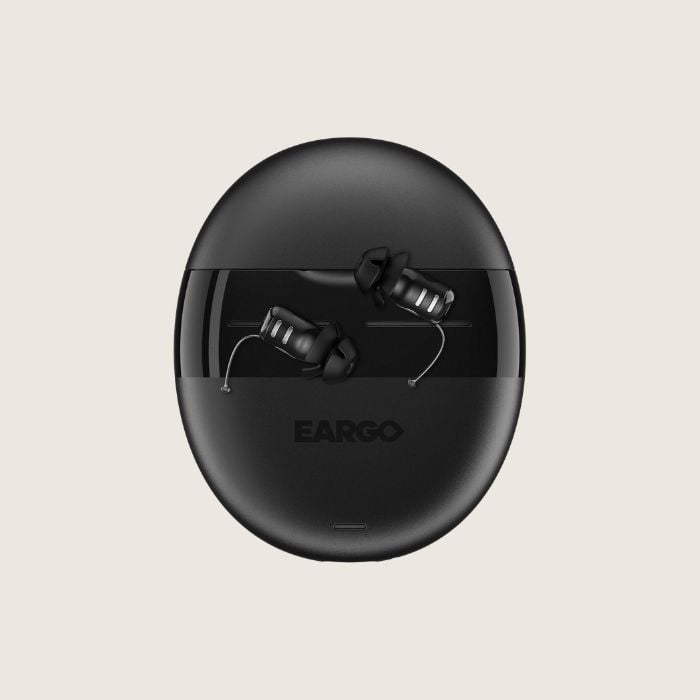
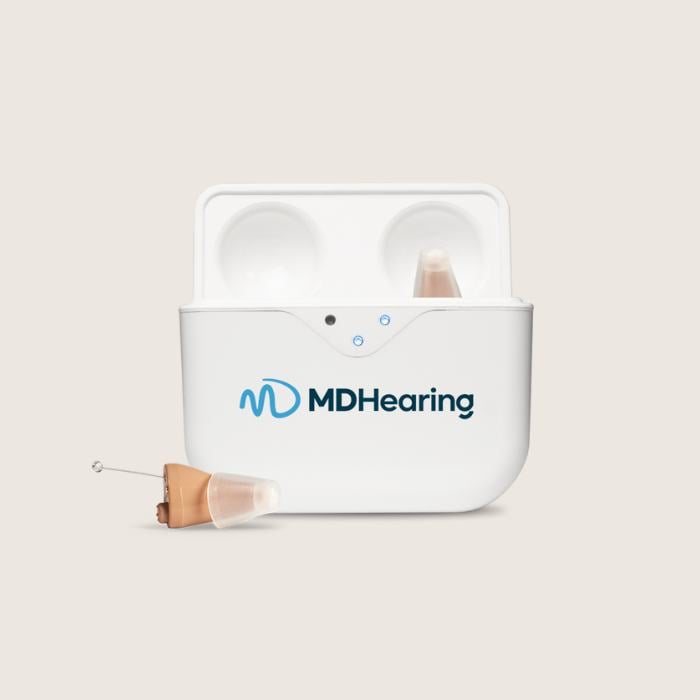
.jpg)

